Vertical pallet gardens transform unused walls, fences, and small outdoor areas into lush, space-saving green sanctuaries. From simple herb displays to multi-pallet privacy walls, repurposed wooden pallets offer endless creative potential. Whether you’re seeking an instant kitchen garden near your patio or a striking living wall, these ideas blend functionality with rustic charm. Many designs incorporate elements like hooked planters, landscape fabric linings, or irrigation systems to maximize plant health and ease of maintenance. Succulents, herbs, leafy greens, flowers, and even strawberries thrive in these vertical environments, making pallet gardens ideal for urban balconies, small backyards, and DIY enthusiasts looking to upcycle materials into beautiful, eco-friendly installations.
1. Hooked Planter Pallet Fence

Covering a bare fence instantly, this design uses a pallet leaned against or mounted on the fence as a framework for small hooked planters. Each hook suspends a pot of herbs—such as mint, thyme, rosemary, sage, or lemon verbena—creating a functional kitchen garden just steps from your cooking area. Placement near the patio ensures fresh herbs are always within reach, while frequent harvesting and consistent watering maintain plant vigor. When seasons change, simply swap out planters for different herbs or flowers, keeping your vertical display attractive year-round.
2. Succulent Pallet Garden
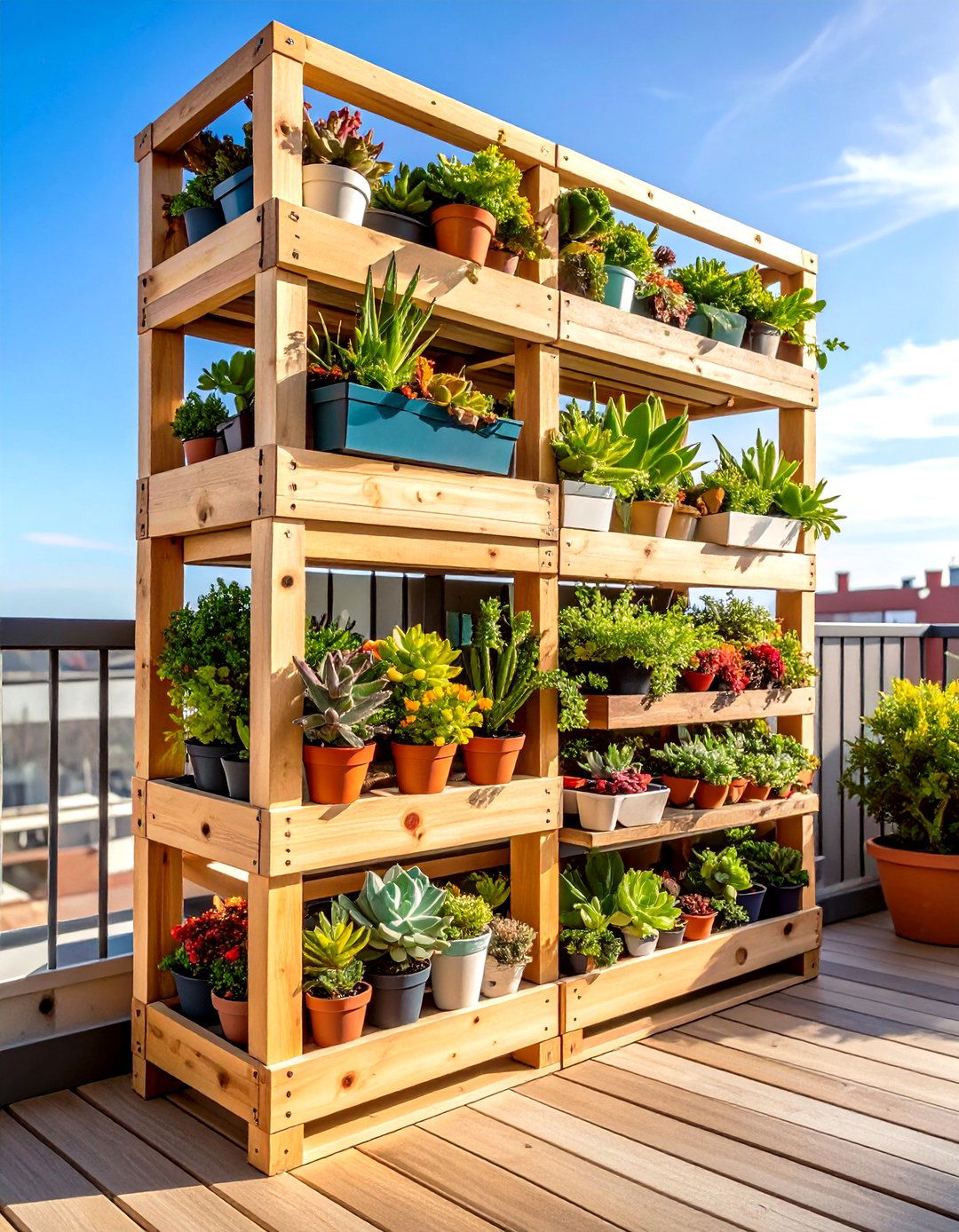
Succulents thrive in drought-tolerant, low-maintenance arrangements, making them perfect for a stained wood pallet frame mounted vertically. By attaching bottoms to each “shelf” of the pallet and lining them with rich organic potting soil, you create pockets that cradle echeverias, sedums, and other hardy varieties. The open slats allow for drainage and air circulation, preventing root rot. This sun-loving mosaic adds year-round texture and color, and the compact design fits balconies, patios, or even indoor accent walls with bright indirect light.
3. Tiered Herb Pallet Shelf
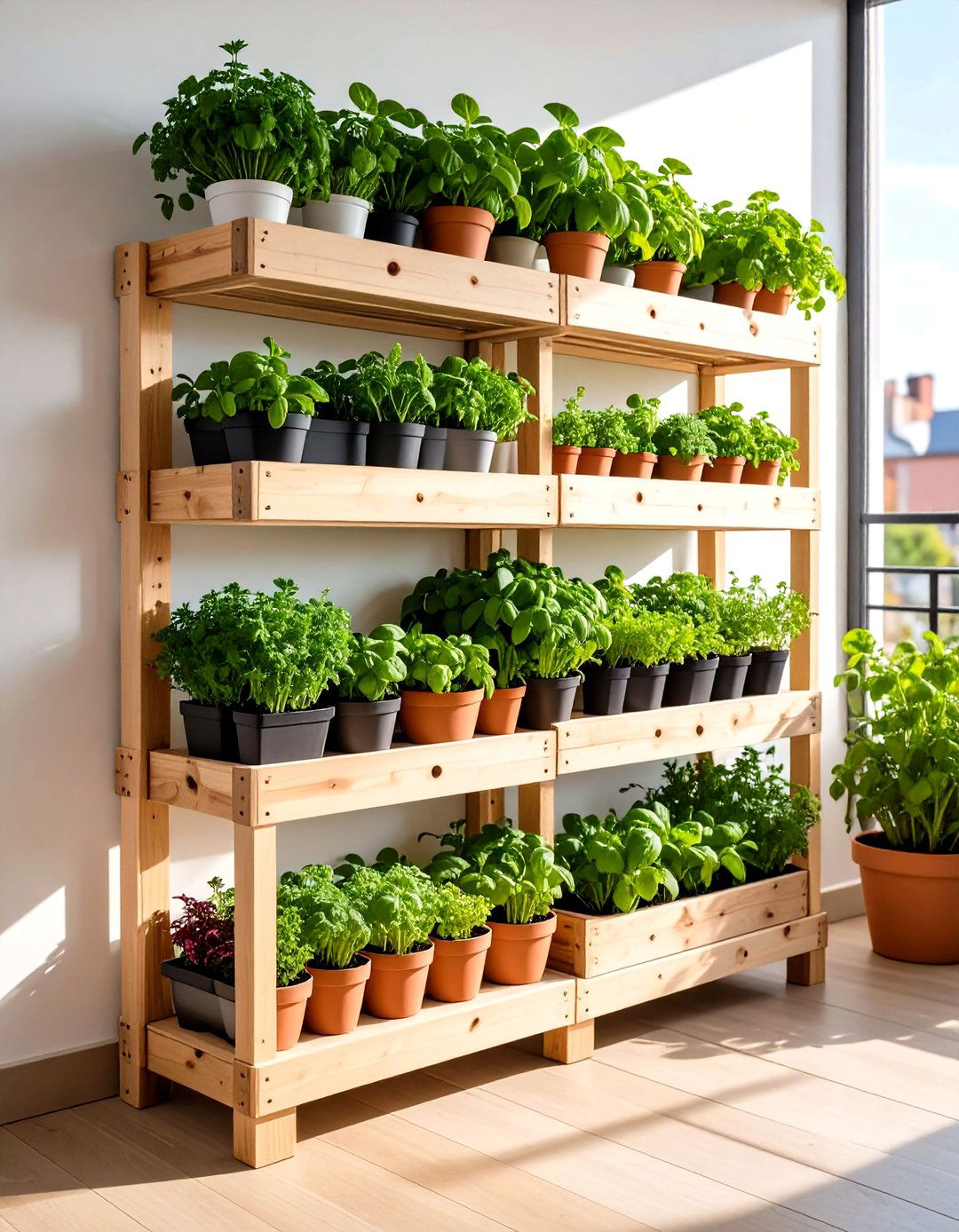
For cooks who love variety, a tiered herb pallet shelf leans flat initially to settle soil, then stands upright against a kitchen wall. Each tier is deep enough to support basil, parsley, cilantro, and oregano, providing ample root space. Lining the pallet’s backside and front with landscape fabric retains soil, while the built-in tiers eliminate the need for individual pots. This approach offers more soil volume for healthier herb growth and integrates effortlessly into outdoor kitchens or balcony walls, supplying fresh flavors all season long.
4. Fabric-Lined Vertical Lettuce Pallet

Transform a wooden pallet into a vertical lettuce planter by stapling landscape fabric to its front and back, creating a secure soil pocket. After laying the pallet face down, add soil and optional drip irrigation tubing before sealing the back. Stand it upright and allow soil to settle over a couple of days, watering to compact the mix. Cut small openings for planting lettuce seedlings, ensuring each variety has room to spread. This efficient use of space yields continuous leafy green harvests and can be rotated to optimize sun exposure on balconies or small yards.
5. Landscape Fabric Succulent Frame
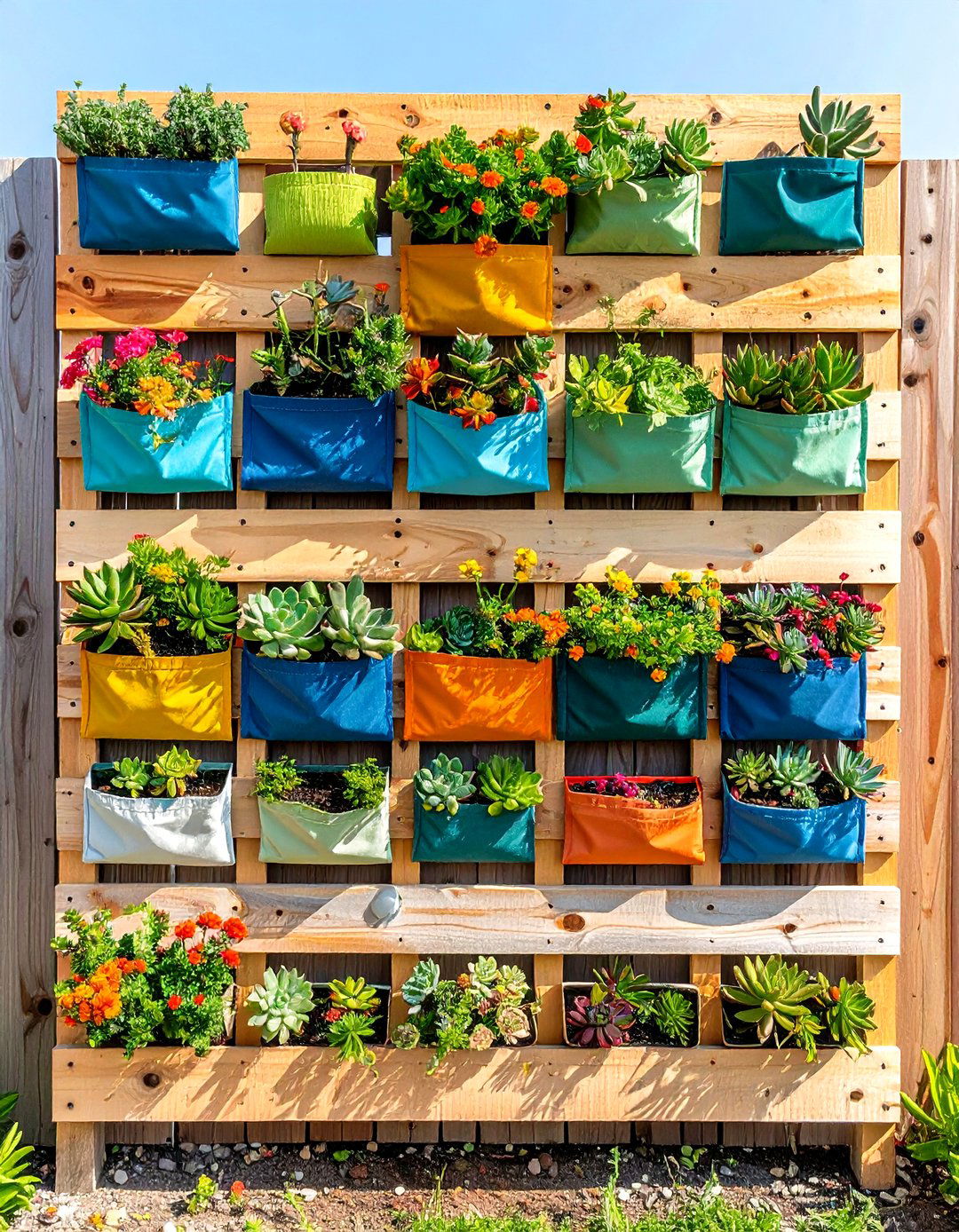
By removing every other pallet slat and stapling landscape fabric across the openings, you create shallow planting pockets ideal for succulents and small annuals. Fill each compartment with gritty potting mix, then nestle succulents into the fabric slots. The removal of alternate slats adds dimension, and the fabric holds soil securely while allowing water to drain. This light, breathable design reduces weight and simplifies hanging on fences or walls, offering an eye-catching succulent gallery that flourishes with minimal care.
6. Soil Netting-Reinforced Pallet

Prevent soil spillage in steep-angle pallet gardens by lining the planting face with durable soil netting as well as landscape fabric. Secure both materials around the pallet’s edges with heavy-duty staples, then fill with a lightweight potting mix. Soil netting adds extra support, especially useful for heavier potting soils or vegetable plantings. Starting seeds directly in the pockets ensures roots establish without shifting. This reinforcement is particularly valuable in windy locations or angled installations, keeping soil and plants firmly in place for consistent growth.
7. Upcycled Pot Pallet Wall
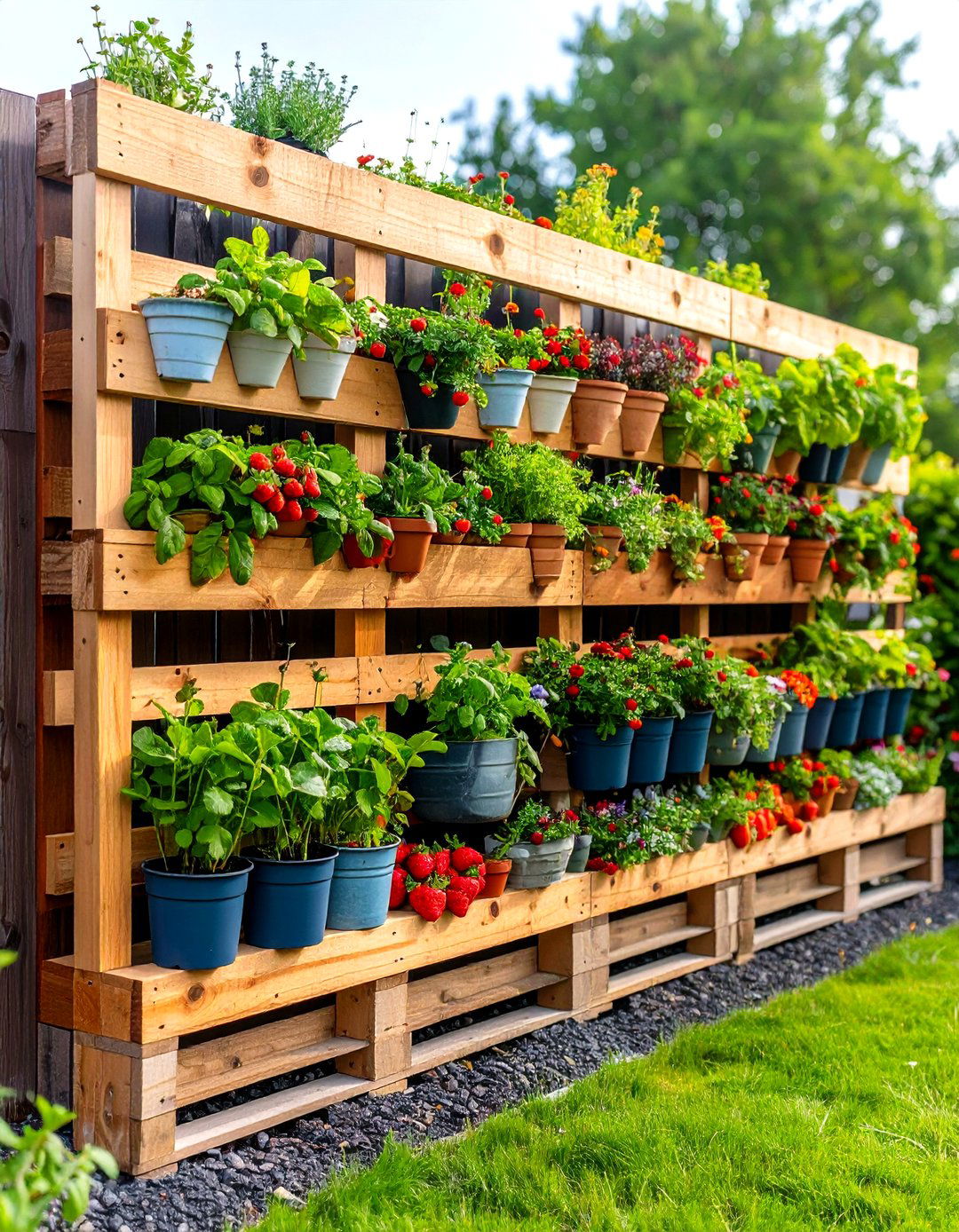
Avoid concerns about chemical-treated pallets by using the pallet simply as a decorative frame for upcycled pots and jars. Attach old ceramic or tin containers to the slats with sturdy wire or S-hooks, then fill them with salad leaves, chillies, or strawberries. Painting the pallet and pots adds flair and coordinates with garden décor. This method separates plants from direct pallet contact, enabling safe edible cultivation without chemical leaching worries. The result is a customizable, modular wall garden that’s easy to rearrange and repaint each season.
8. Painted Mosaic Succulent Pallet
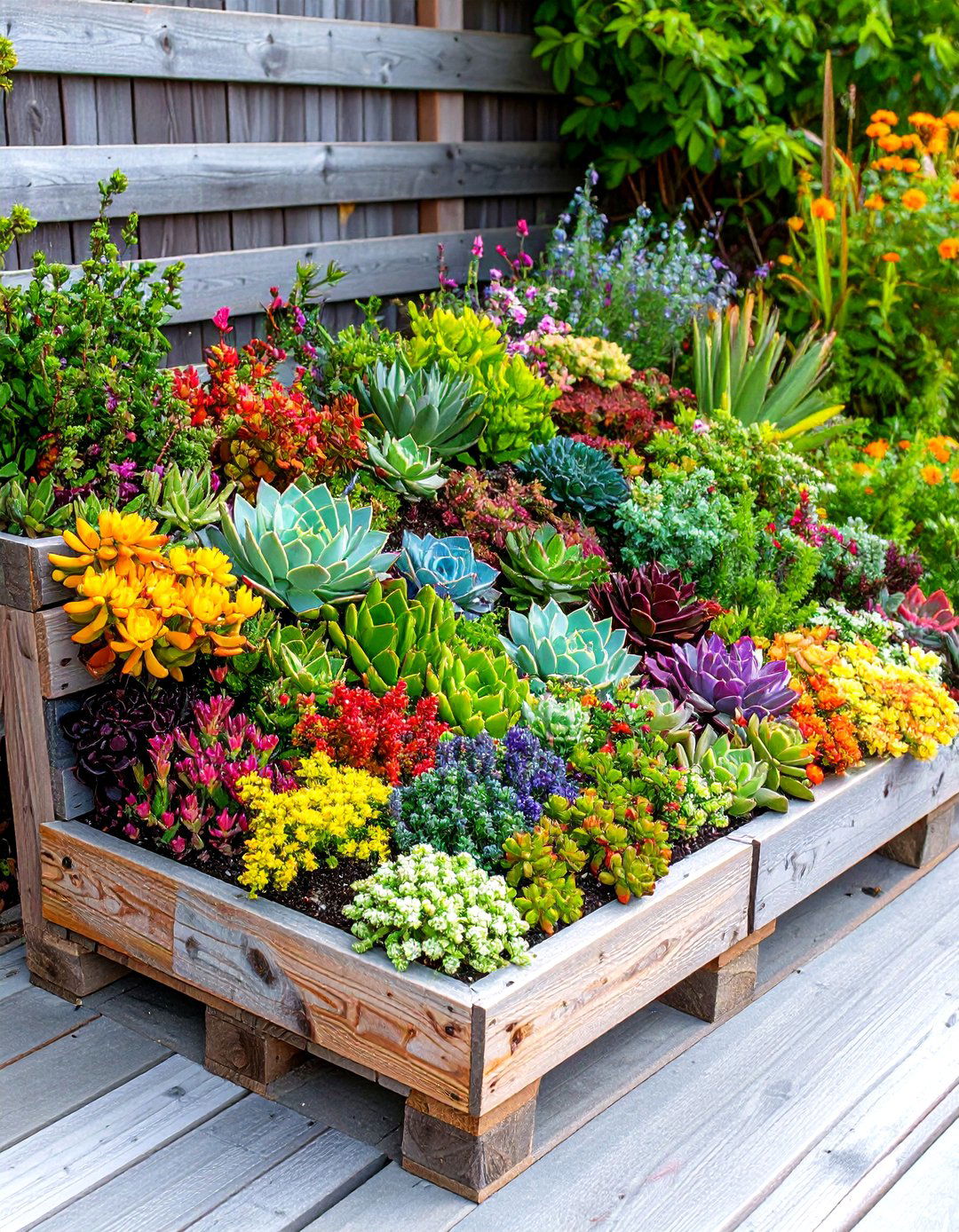
Elevate a basic succulent pallet by painting each wood slat in alternating colors before arranging succulents in the pockets. After allowing the paint to cure fully, staple landscape fabric and fill with cactus-friendly potting soil. Then, insert a mix of jade, haworthia, sedum, and trailing succulents for a textured mosaic effect. The contrast between painted wood and vibrant succulents turns a simple pallet into living art. Hang or lean it where it receives bright, indirect light for a living mosaic that doubles as modern outdoor décor.
9. Irrigated Living Wall Pallet

For a low-maintenance living wall, integrate a drip irrigation line at the top of a fabric-lined pallet. The line weaves through each slat pocket, dripping water slowly to ensure even moisture distribution. Ideal for ivies, climbing roses, and indoor houseplants like Monstera or peace lilies, this system maintains optimal humidity and reduces daily watering. Mount the pallet securely, and connect to a timer for automated irrigation. This approach produces lush vertical greenery that enhances privacy, air quality, and aesthetic appeal in urban settings.
10. Multi-Frame Pallet Grid
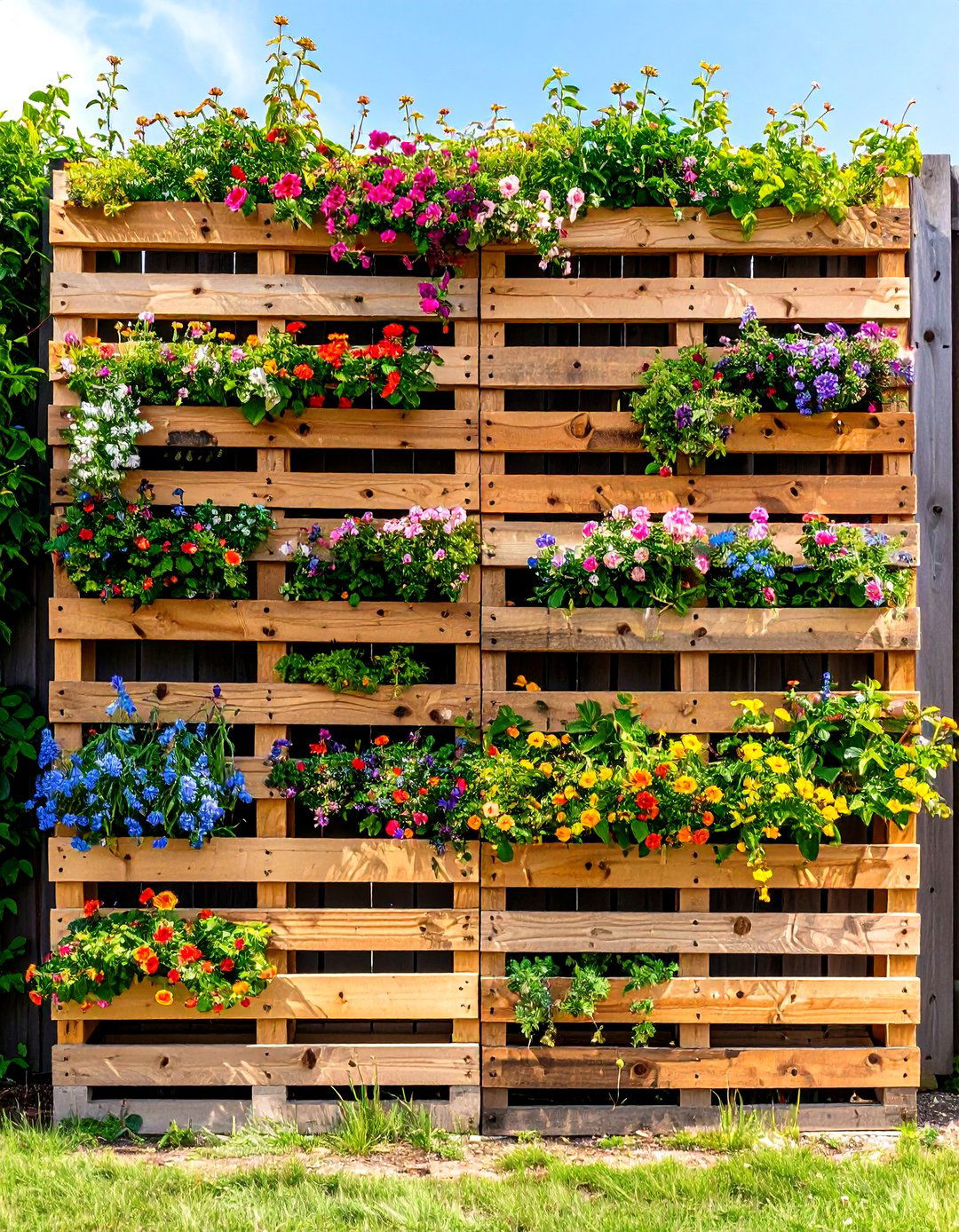
Create a large statement wall by linking several pallet frames into a grid. Secure each pallet side by side and top to bottom, forming a continuous surface for planting. Line all facing surfaces with landscape fabric, then fill with lightweight soil mix. Plant a mix of climbing vines, ferns, and shade-tolerant flowering plants. The interconnected grid adds structural stability and transforms entire sides of fences or building exteriors into immersive green walls. This scale-up mimics professional living walls but remains achievable with off-the-shelf pallets.
11. Pallet Garden Wall
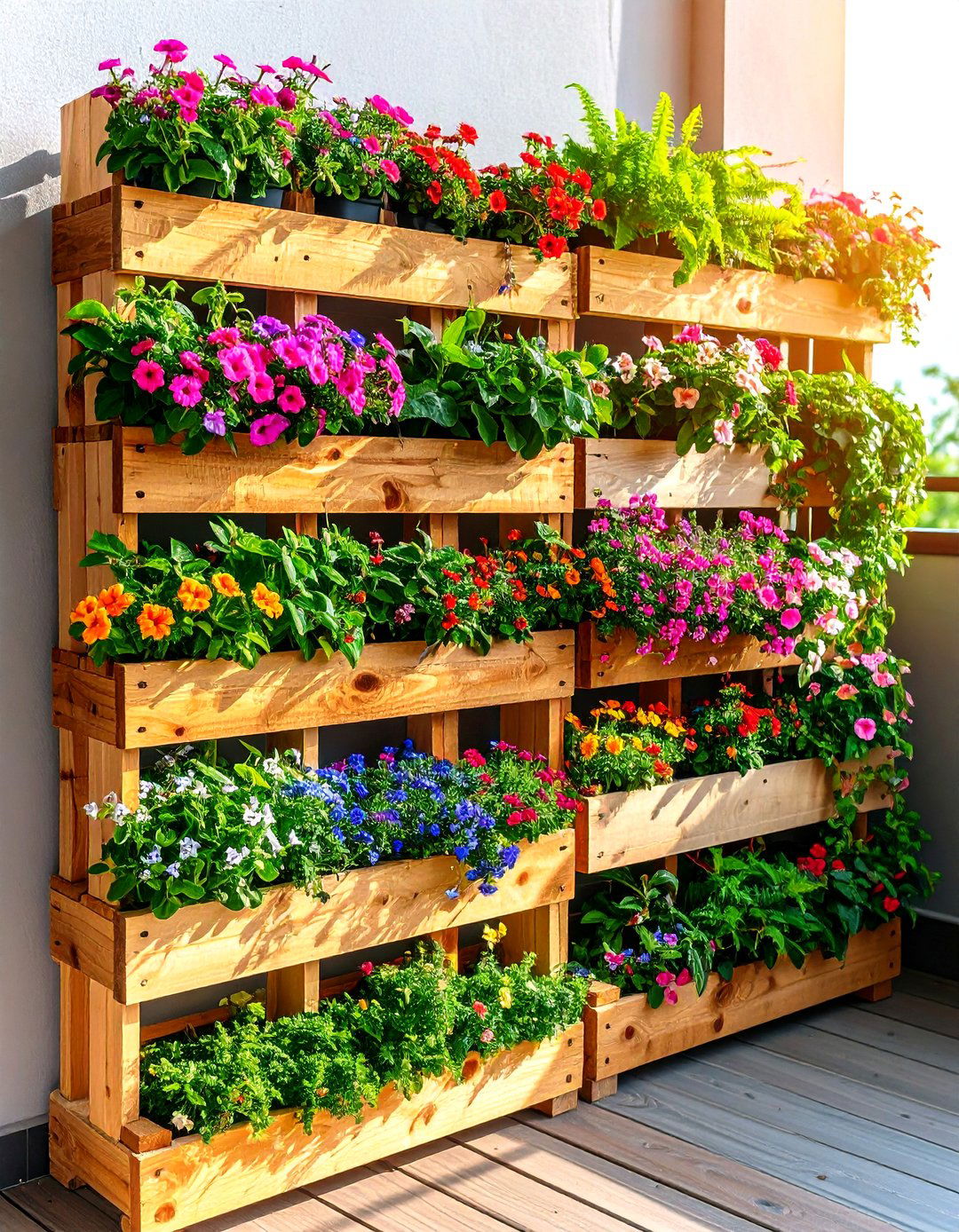
Join multiple pallets to form a standalone garden wall doubling as privacy screening. Secure them together horizontally for a freestanding divider that holds soil-lined pockets at varying heights. Fill with petunias, impatiens, or ferns to soften the structure and add color contrast. This DIY privacy wall thrives in sunny or partially shaded spots and can be relocated if needed. The result is a functional partition covered in living plant material, perfect for small yards or balcony corners.
12. Pallet Vegetable Garden
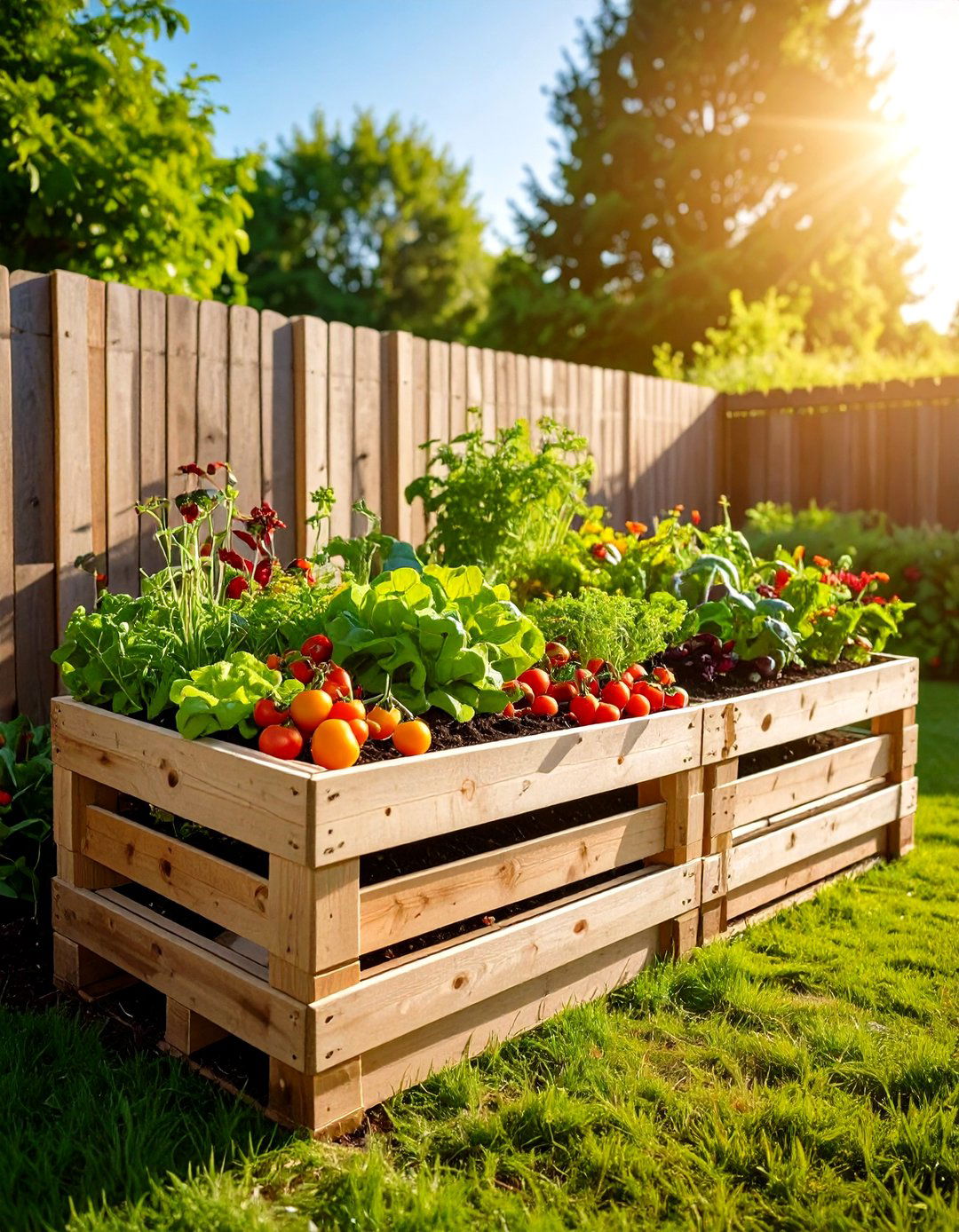
Lean a single pallet against a fence in a full-sun spot and fill with a light, well-draining potting mix. Plant cherry tomatoes, peppers, and lettuce seedlings in staggered rows for easy harvesting. The vertical arrangement improves air circulation, reducing disease risk for vegetables. As plants mature, harvest from top to bottom to maintain even growth. This simple pallet vegetable garden makes fresh produce accessible even in the tiniest outdoor spaces.
13. Pallet Flower Beds
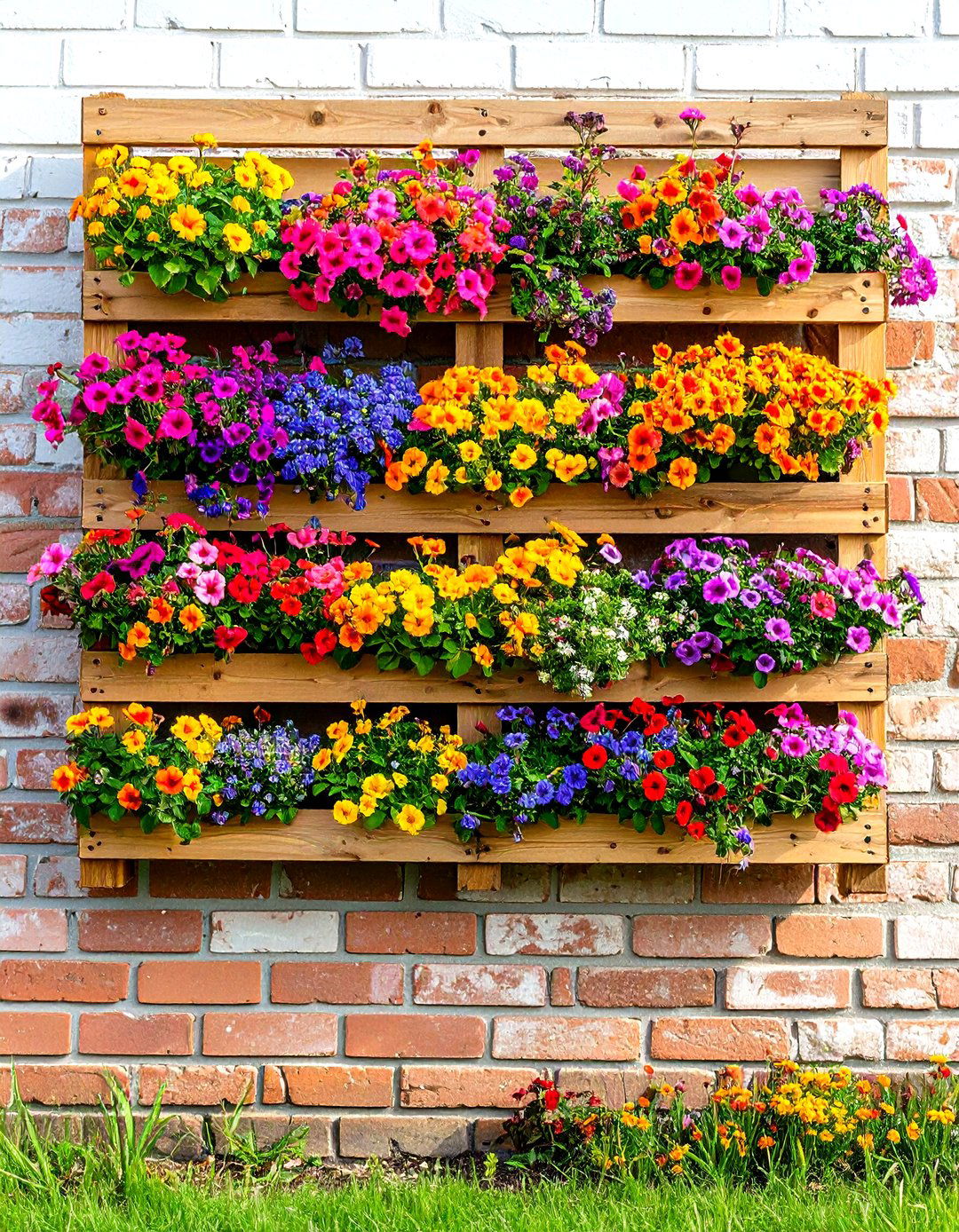
Brighten walls by planting annuals such as marigolds, petunias, and begonias in each pallet shelf. Use peat-based potting mix and add slow-release fertilizer. Arrange flowers by color for a gradient effect, then hang the pallet on a brick or wood wall. The abundant blossoms create a floral tapestry, turning blank vertical surfaces into dynamic, seasonal displays that attract pollinators.
14. Balcony Pallet Garden
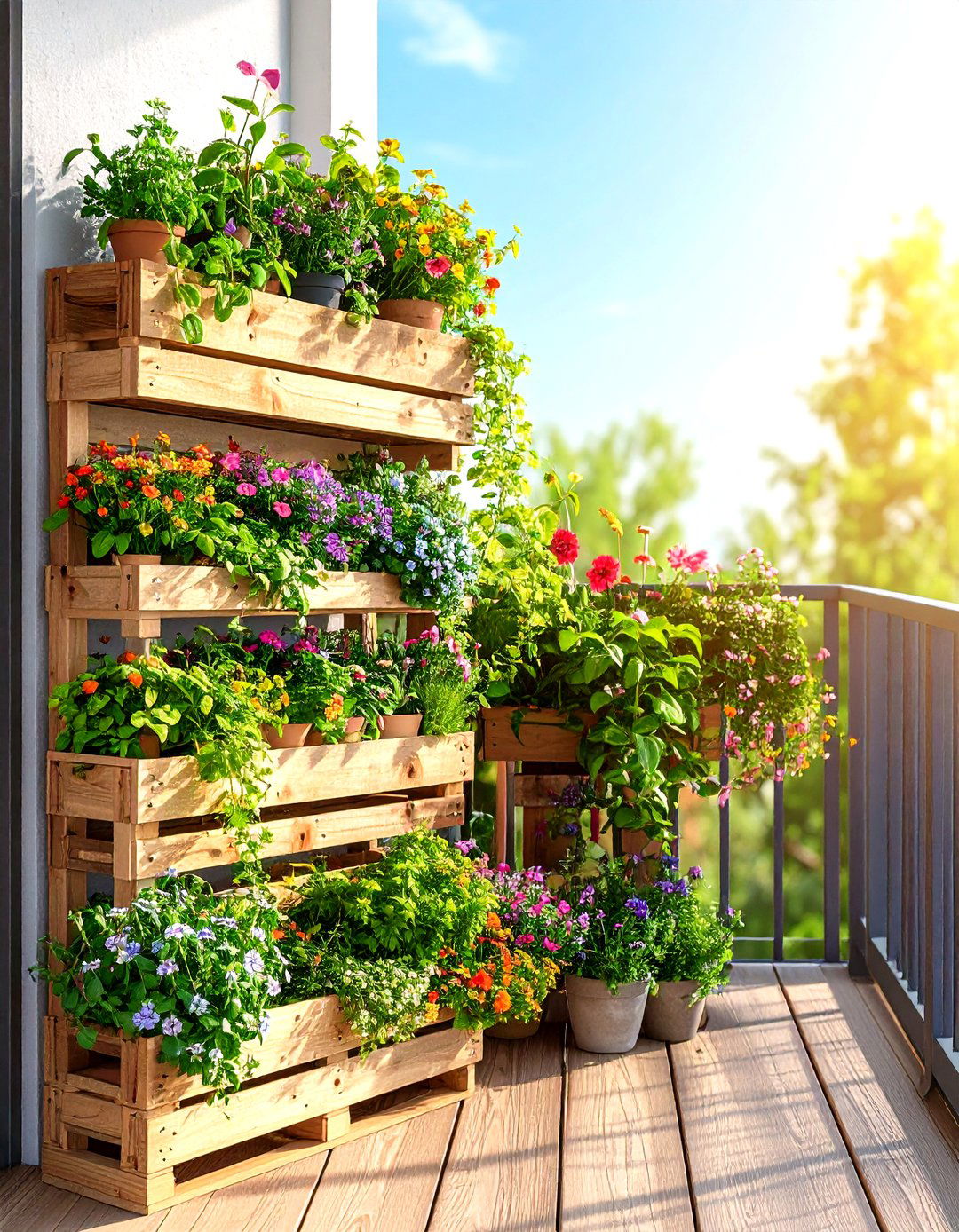
Maximize balcony real estate by leaning a pallet against the railing. Secure with zip ties and line with landscape fabric. Integrate small pots of herbs on the lower levels, trailing flowers like petunias mid-height, and vine plants such as clematis or morning glory at the top. This tiered approach provides easy access to fresh herbs while adding cascading color to your outdoor living area.
15. Colorful Pallet Planters

Personalize your garden by painting pallets in bold hues—turquoise, coral, or sunny yellow—before adding soil and plants. Bright colors complement succulents or tropical foliage, making the pallet pop. Children can join by painting designs or stenciling patterns. This playful approach turns pallets into art installations as much as plant holders.
16. Planter Box Raised Bed
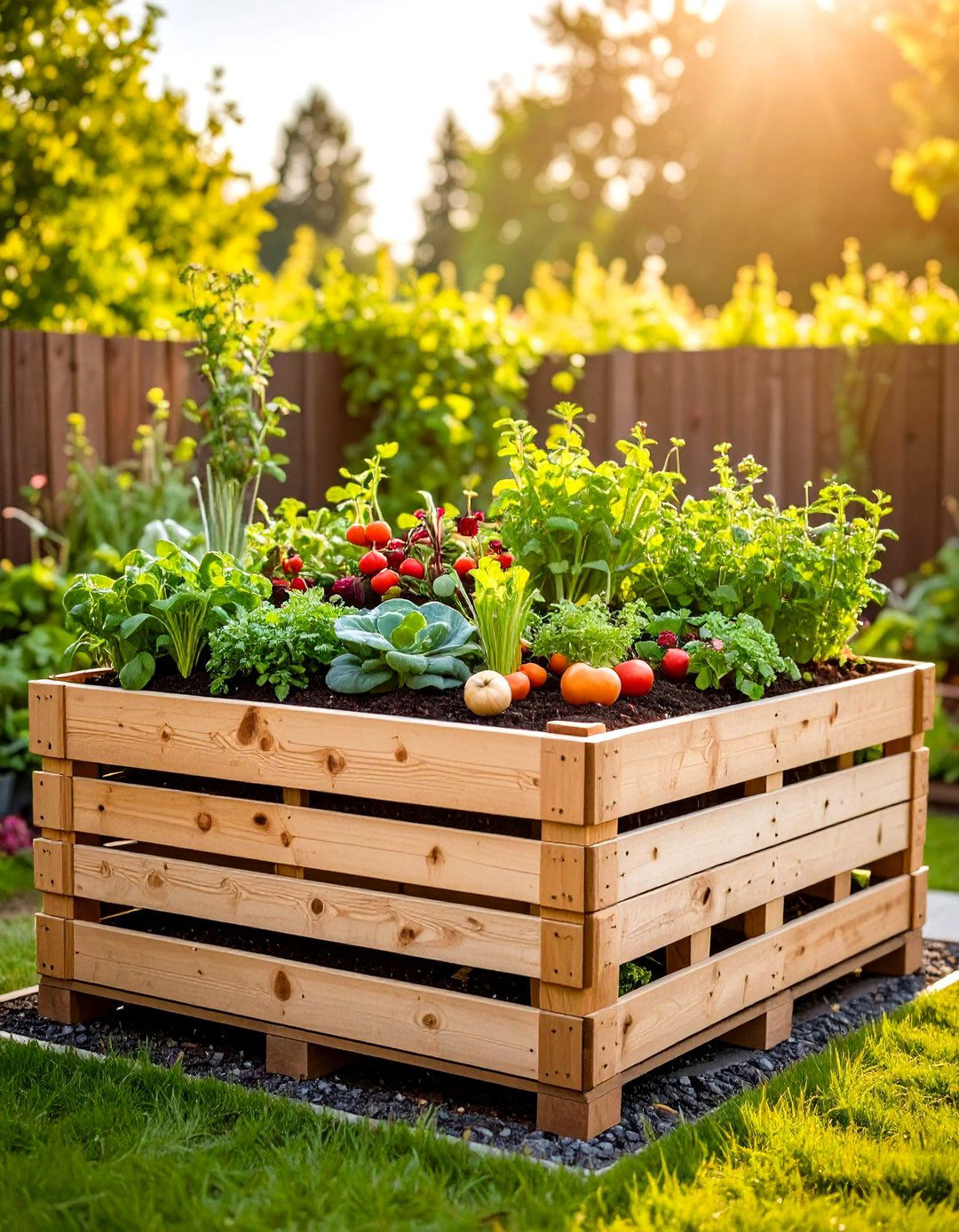
Form a square planter box by attaching four pallets upright and filling the center with soil. Use the adjoining slats to sow herbs or lettuce on the sides. This hybrid raised bed maximizes growing area for larger vegetables while preserving vertical pockets for quick-harvest greens.
17. Pallet Garden Décor
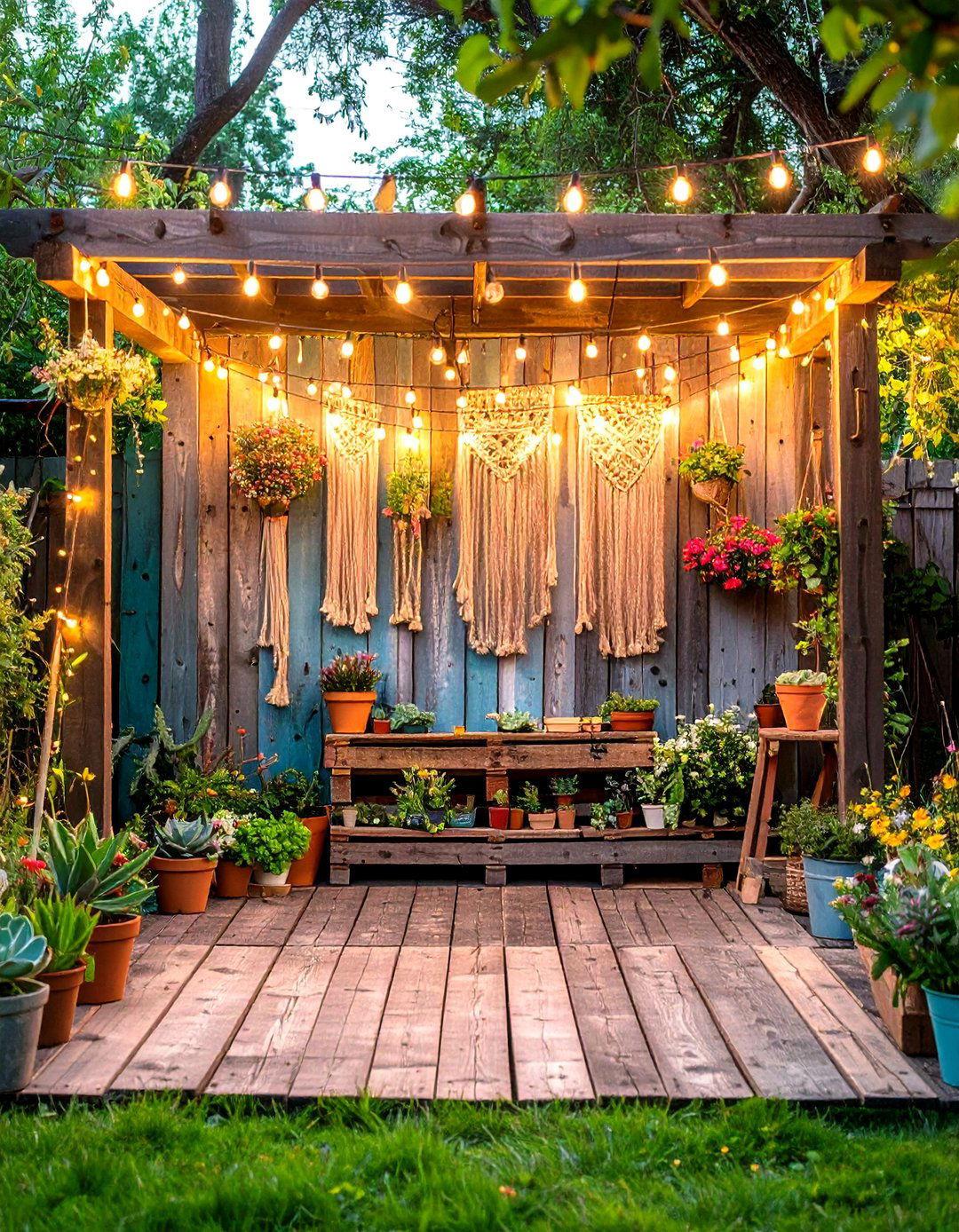
Incorporate decorative elements—macramé hangers, fairy lights, or small chalkboards—into a pallet frame. Use pockets for succulents and add hooks for garden tools. The combined functionality and aesthetics create a focal point that’s both beautiful and practical.
18. Hanging Planter Display
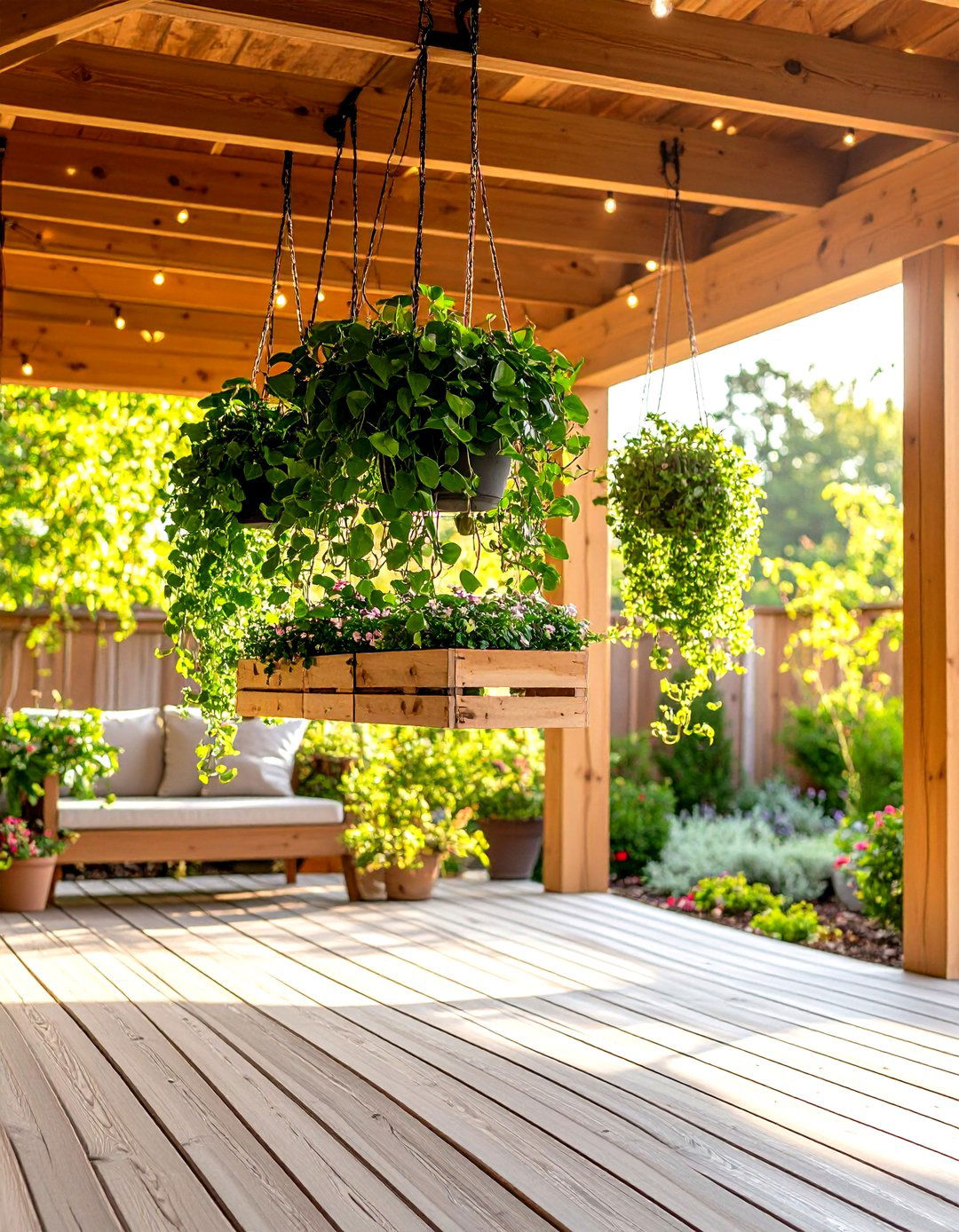
Mount a pallet horizontally from ceiling hooks to craft an inverted hanging planter. Secure landscape fabric, fill with soil, and plant trailing vines like pothos or sweet potato vine. This floating garden works indoors or under covered patios, offering a dramatic overhead green display.
19. Strawberry Tower
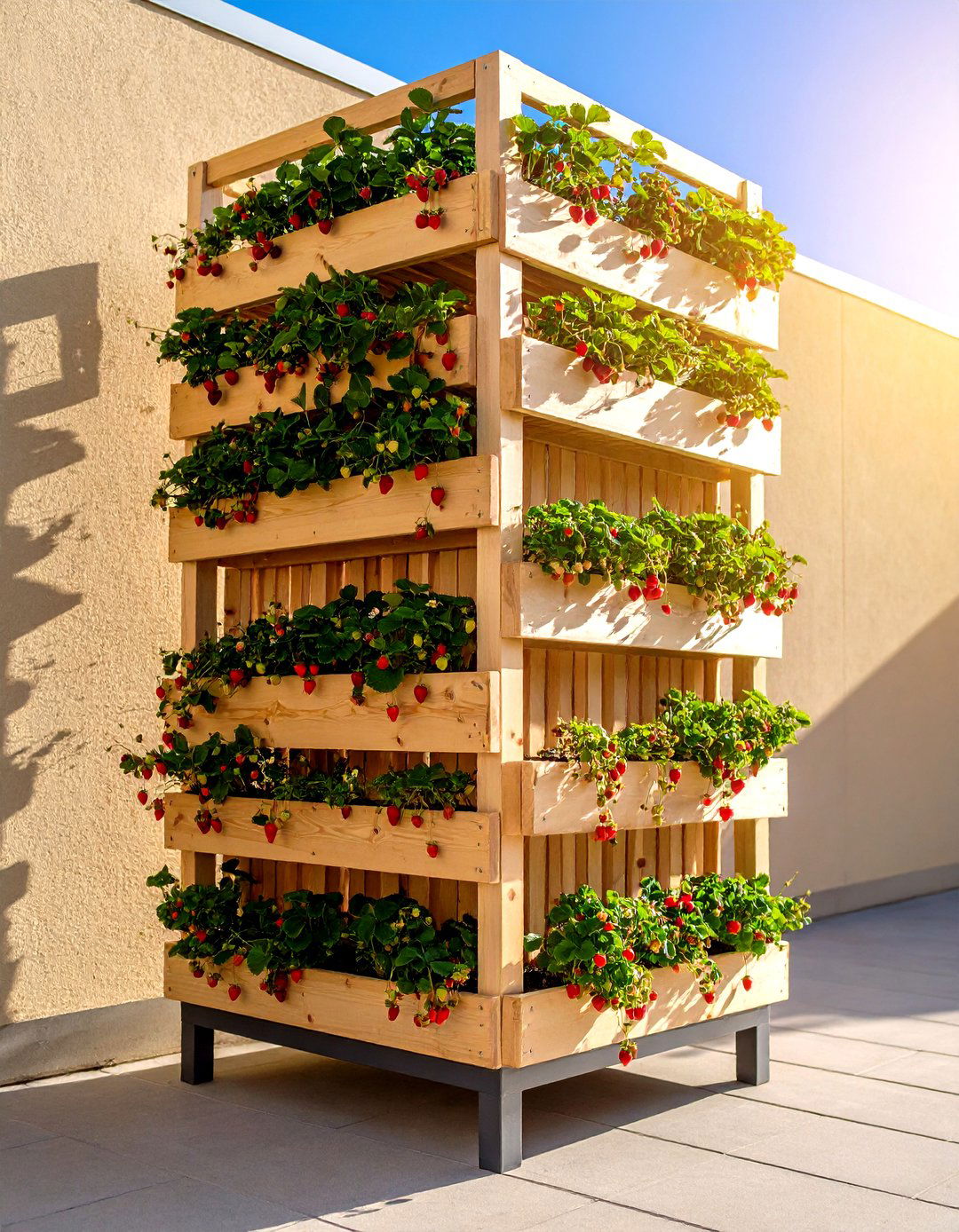
Build a tiered strawberry pallet by filling each horizontal slat pocket with strawberry plants. Choose everbearing varieties for continuous harvest. The elevated design keeps berries off the ground, reducing pests and rot. Positioned near a sunny wall, the tower yields sweet fruit through the growing season.
20. Charming Wildflower Corner

Repurpose a pallet into a wildflower display by planting a mix of daisies, poppies, and coneflowers in the fabric-lined pockets. Lean against a garden wall or fence where it receives morning sun. The blend of native wildflowers attracts pollinators and adds a natural, cottage-garden look to small spaces.
Conclusion:
Vertical pallet gardens offer versatile, budget-friendly solutions for maximizing green space in urban and small-area settings. By combining simple materials—landscape fabric, netting, and upcycled pots—with creative layouts, you can cultivate herbs, vegetables, succulents, and flowers on any wall or fence. Whether you prefer a minimal succulent mosaic or a lush living wall with irrigation, pallet gardens adapt to diverse styles and growing needs. These ideas demonstrate how repurposed pallets can elevate both aesthetics and functionality, transforming vertical surfaces into productive, low-impact garden installations.



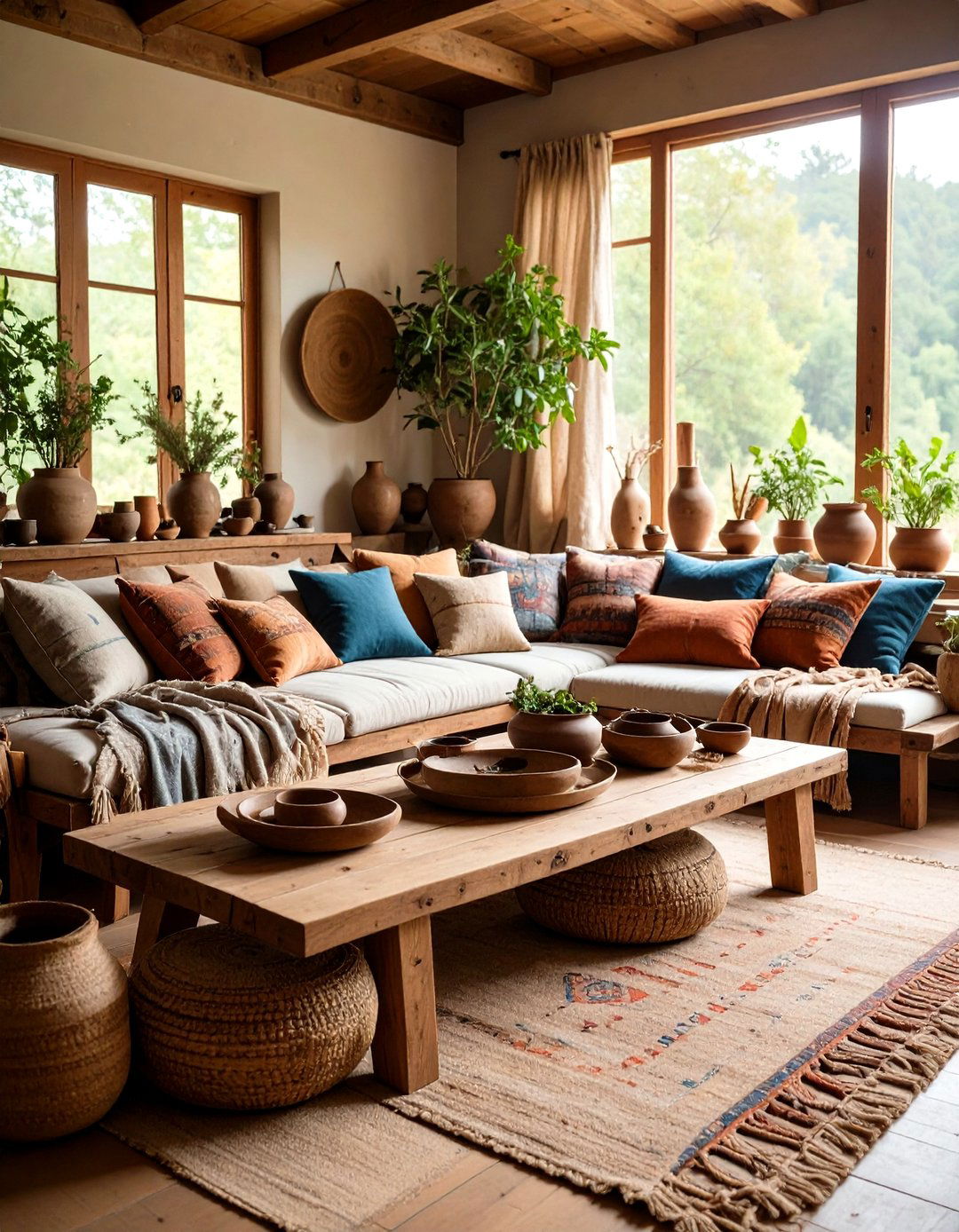

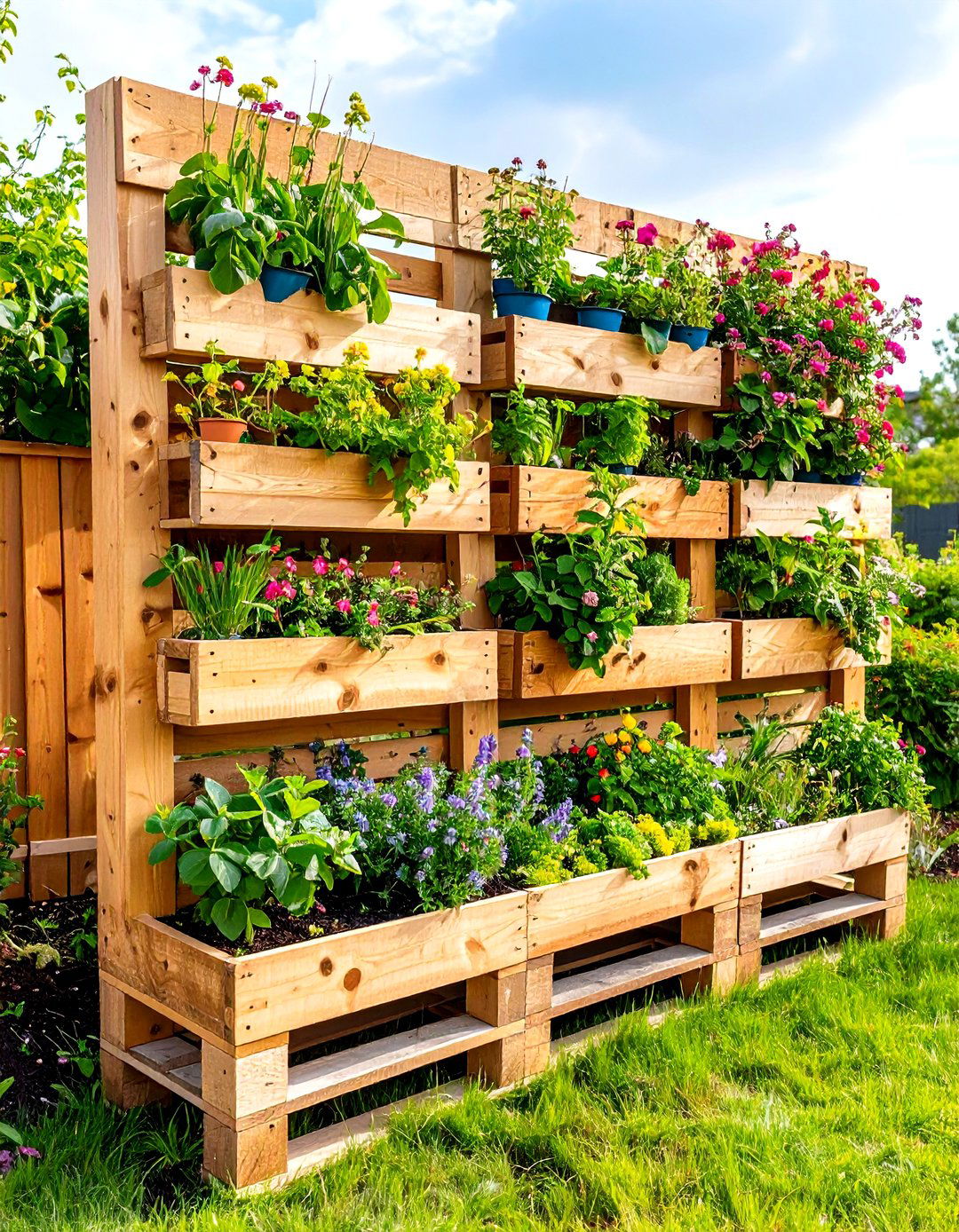
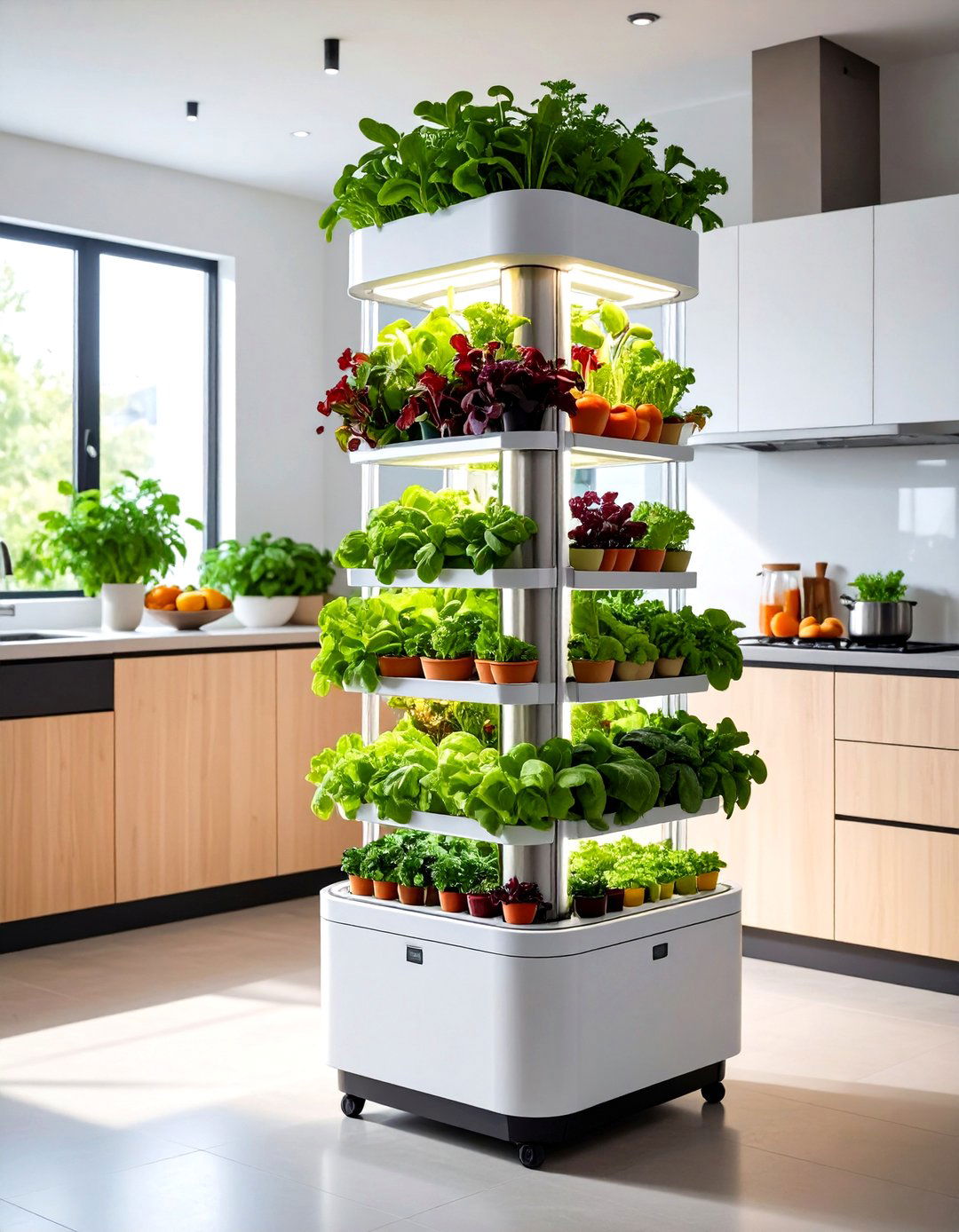
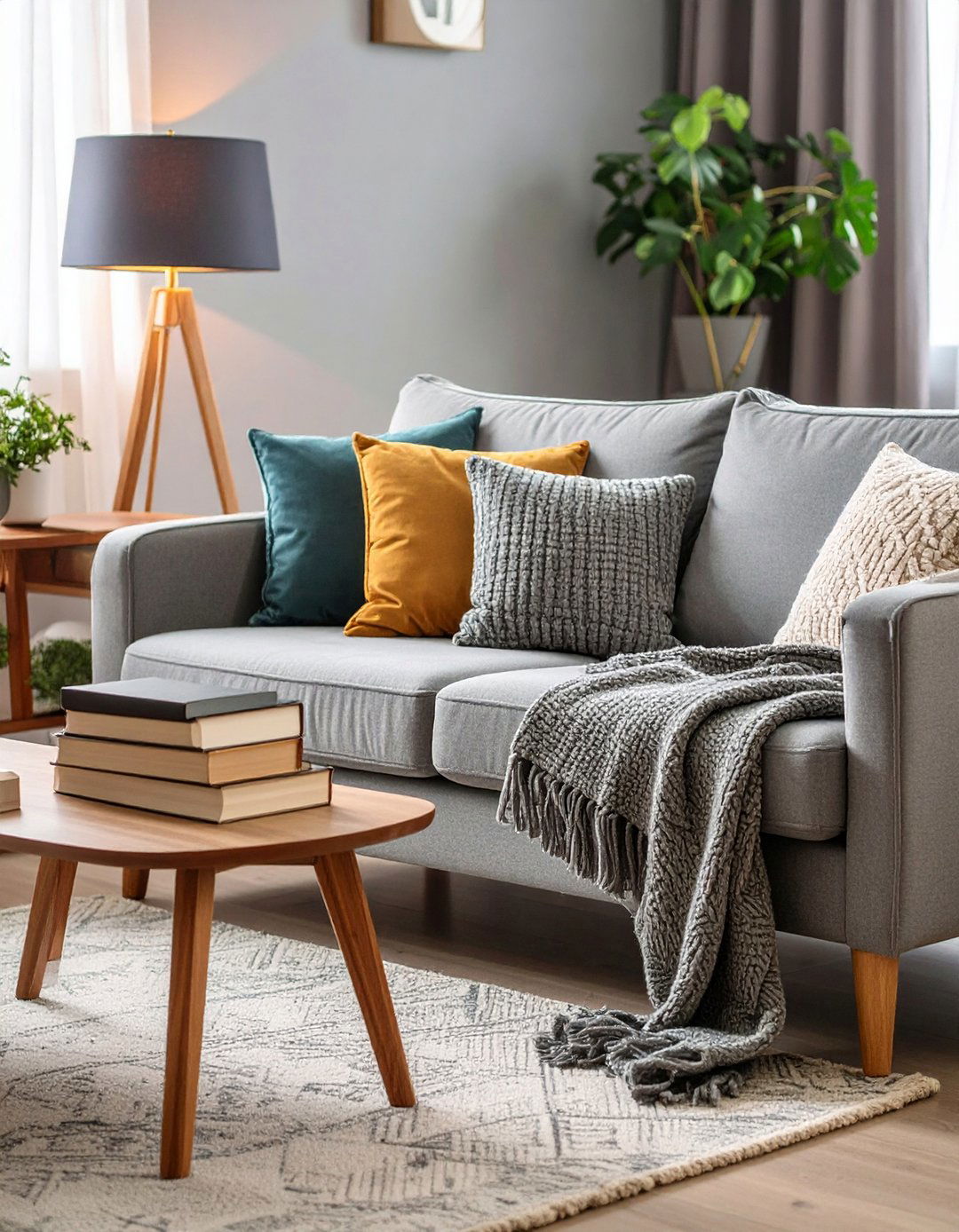
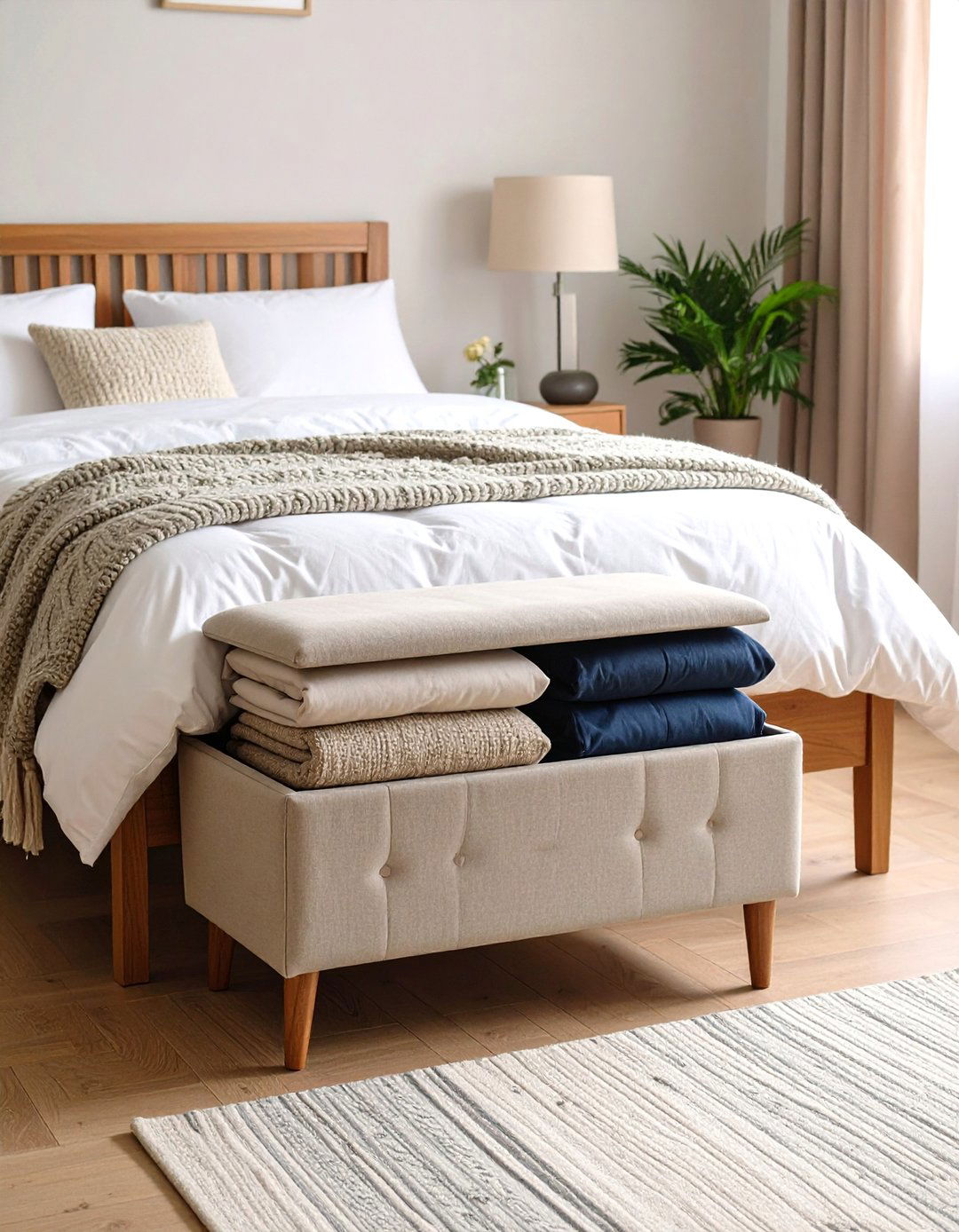
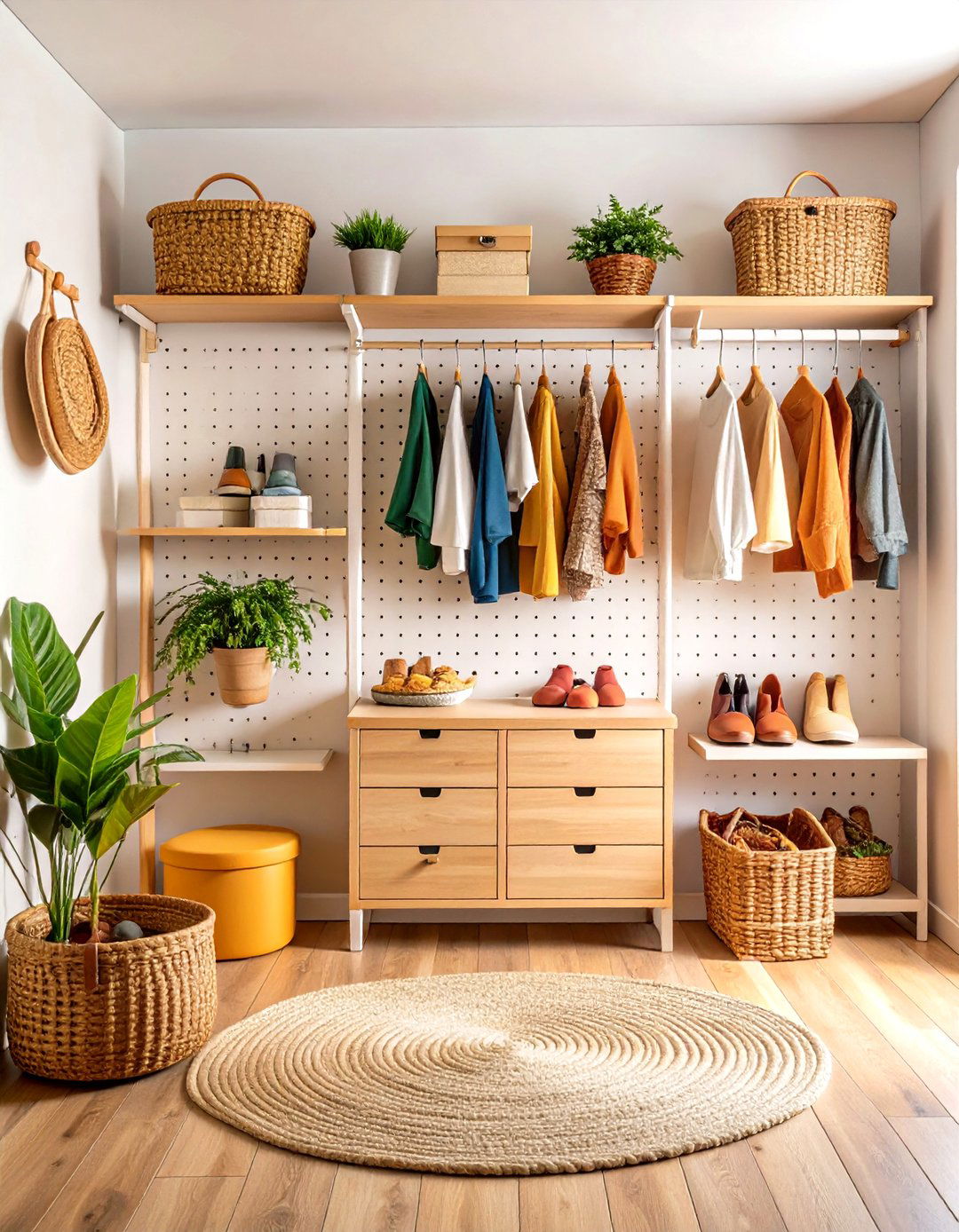
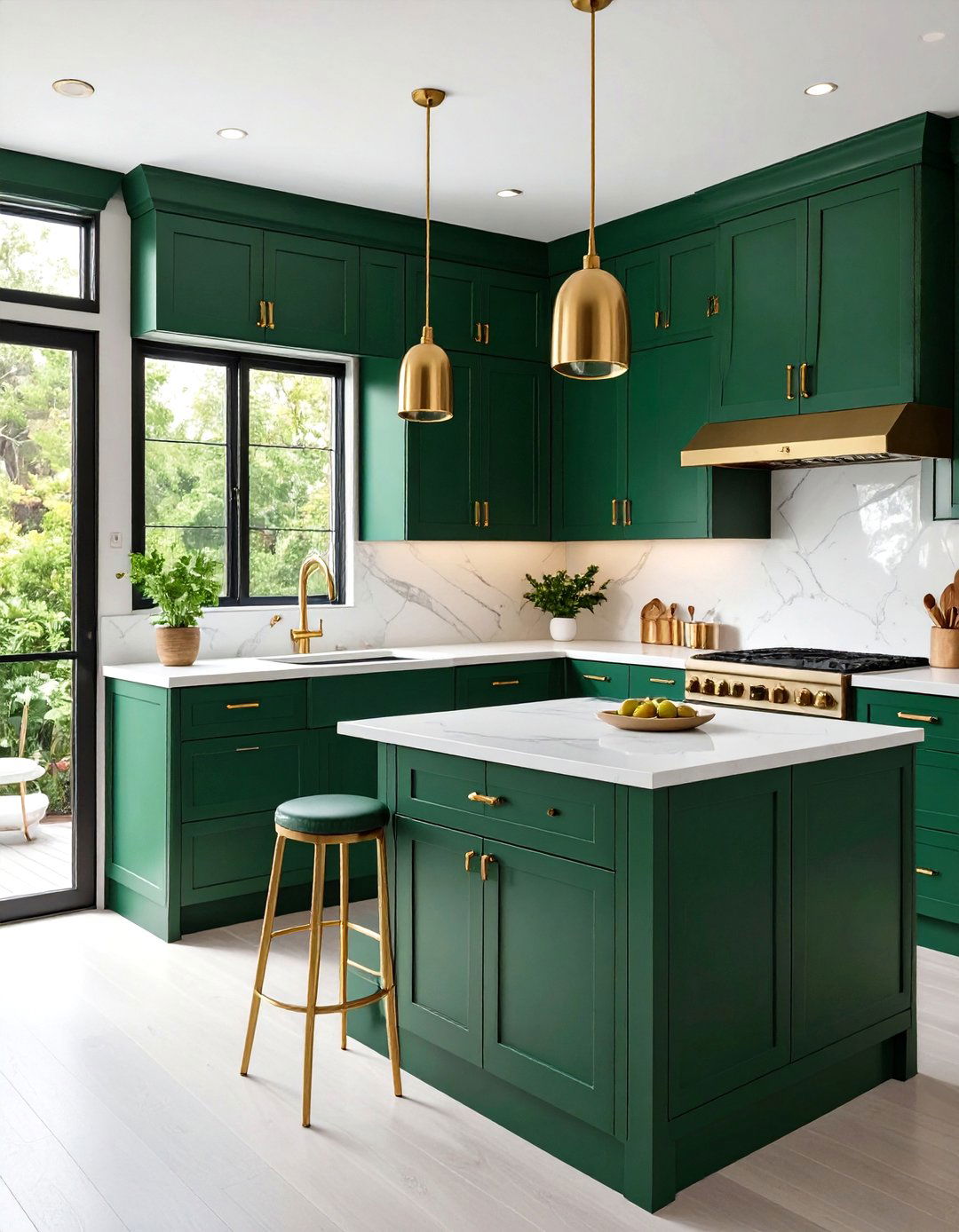
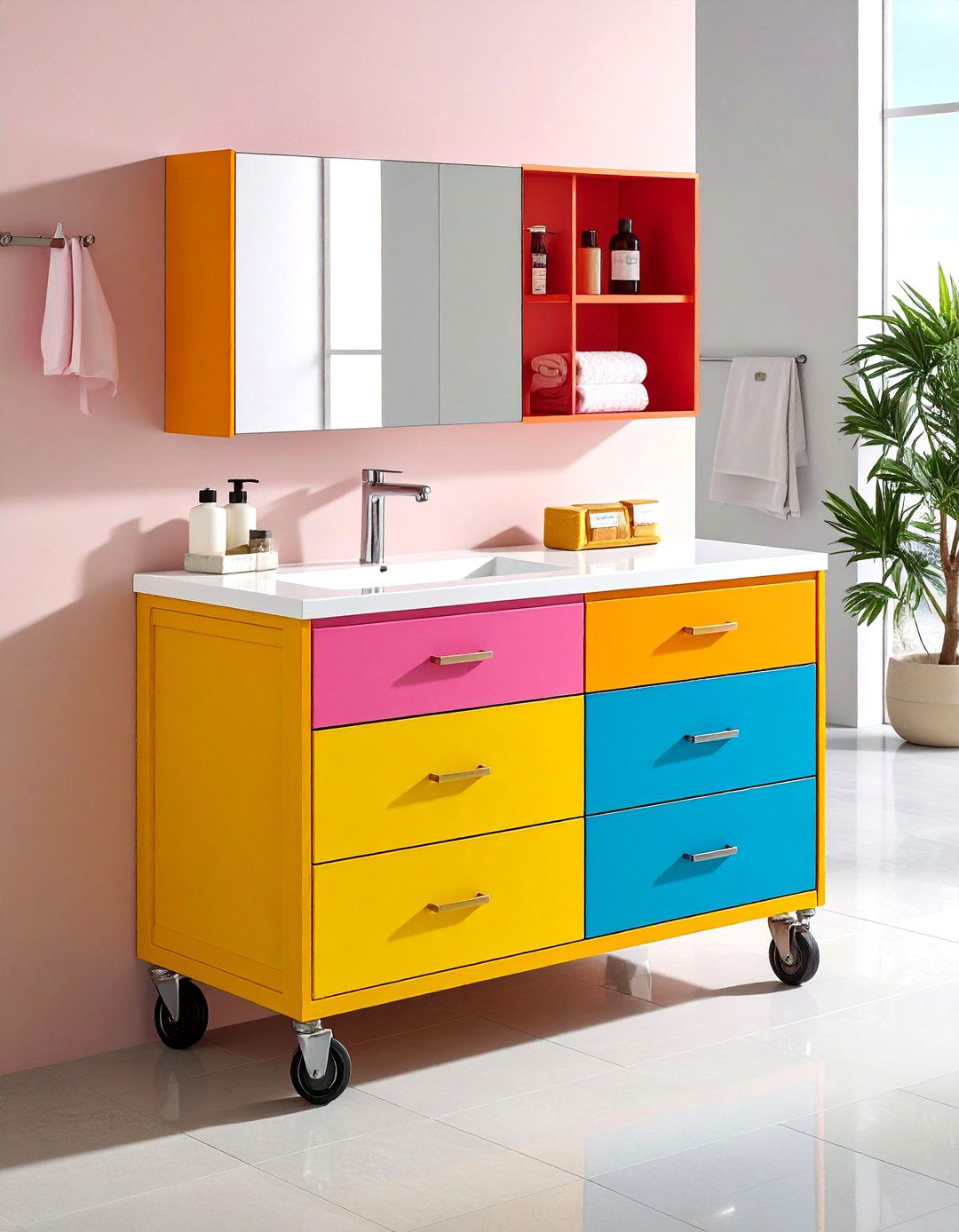
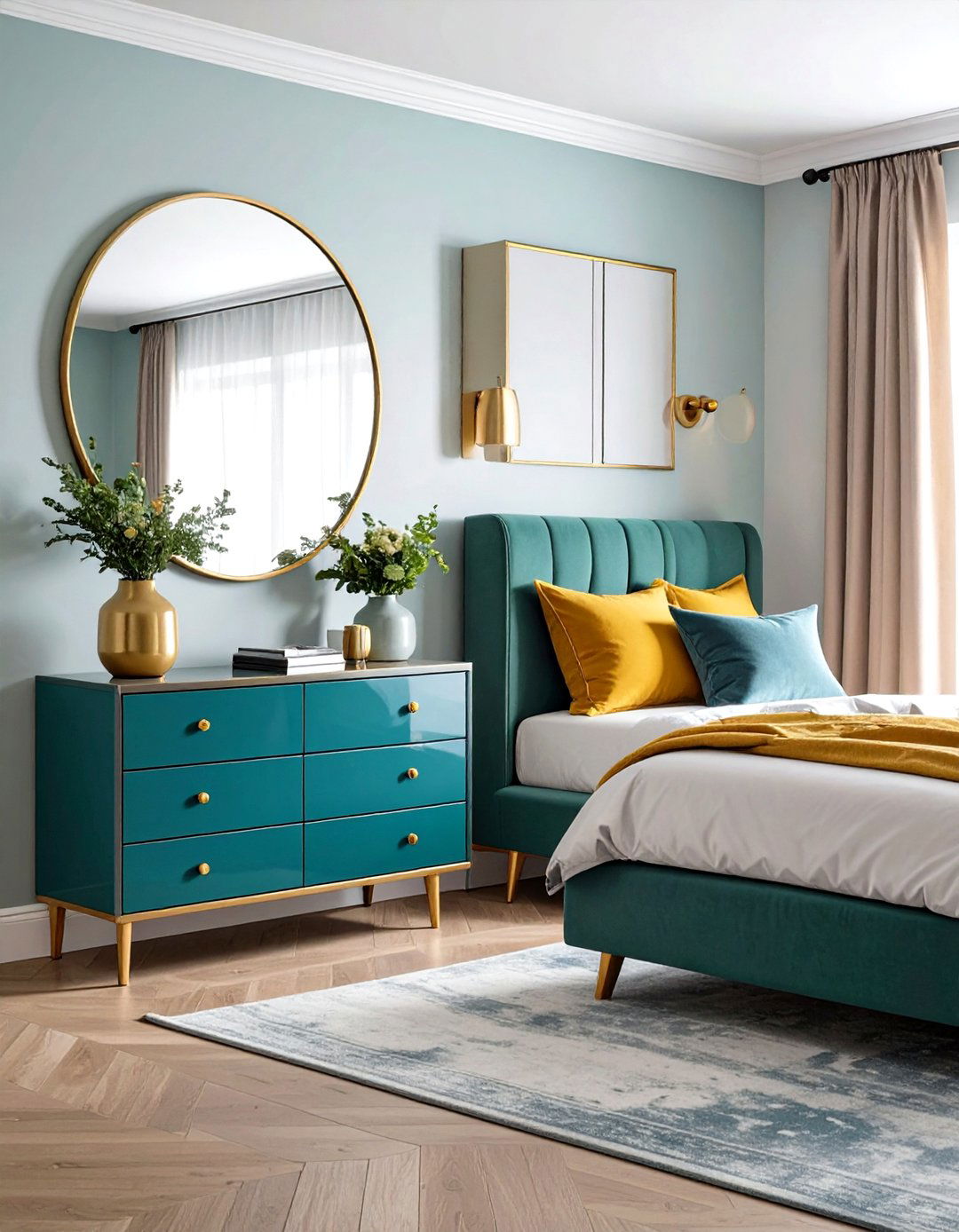
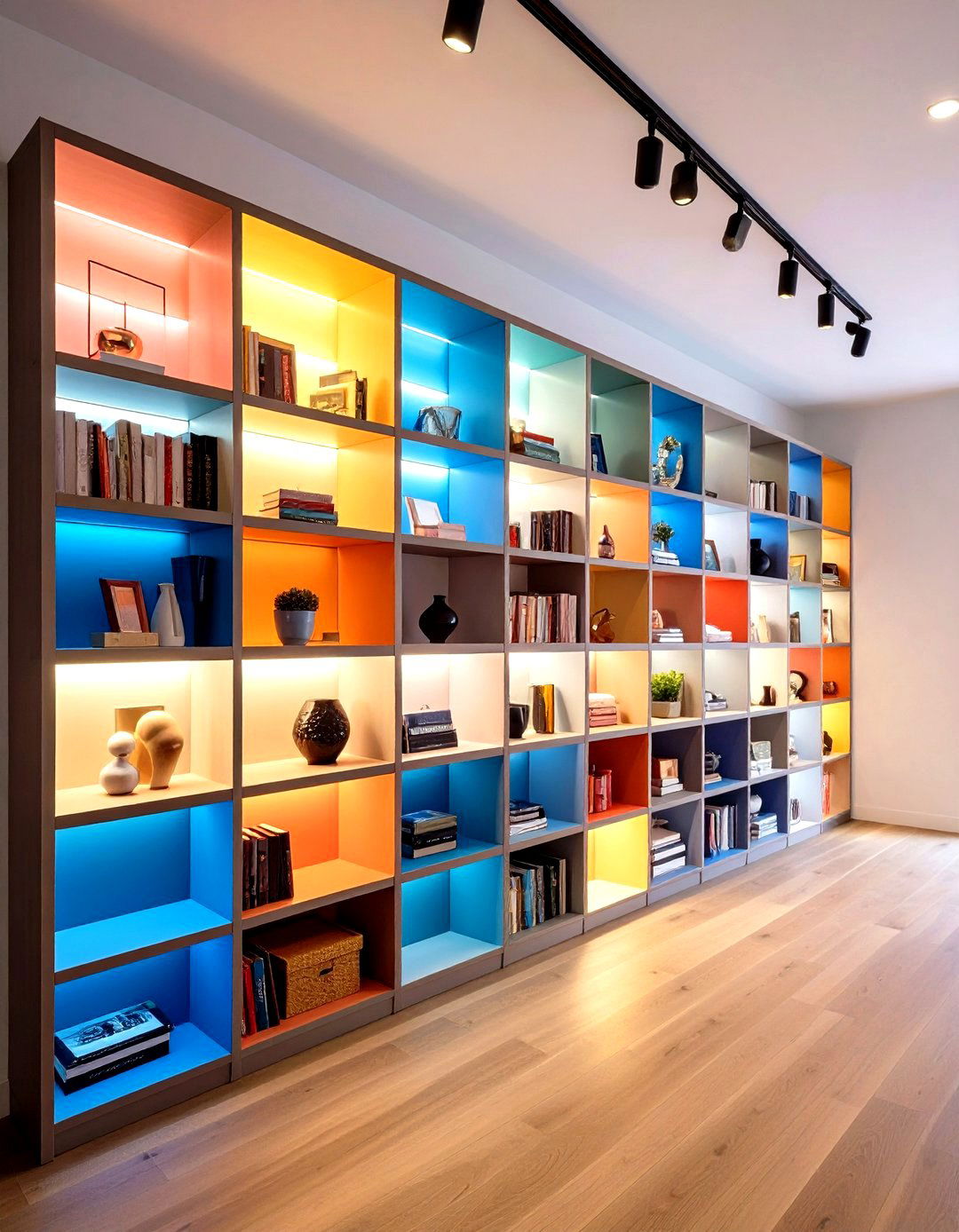
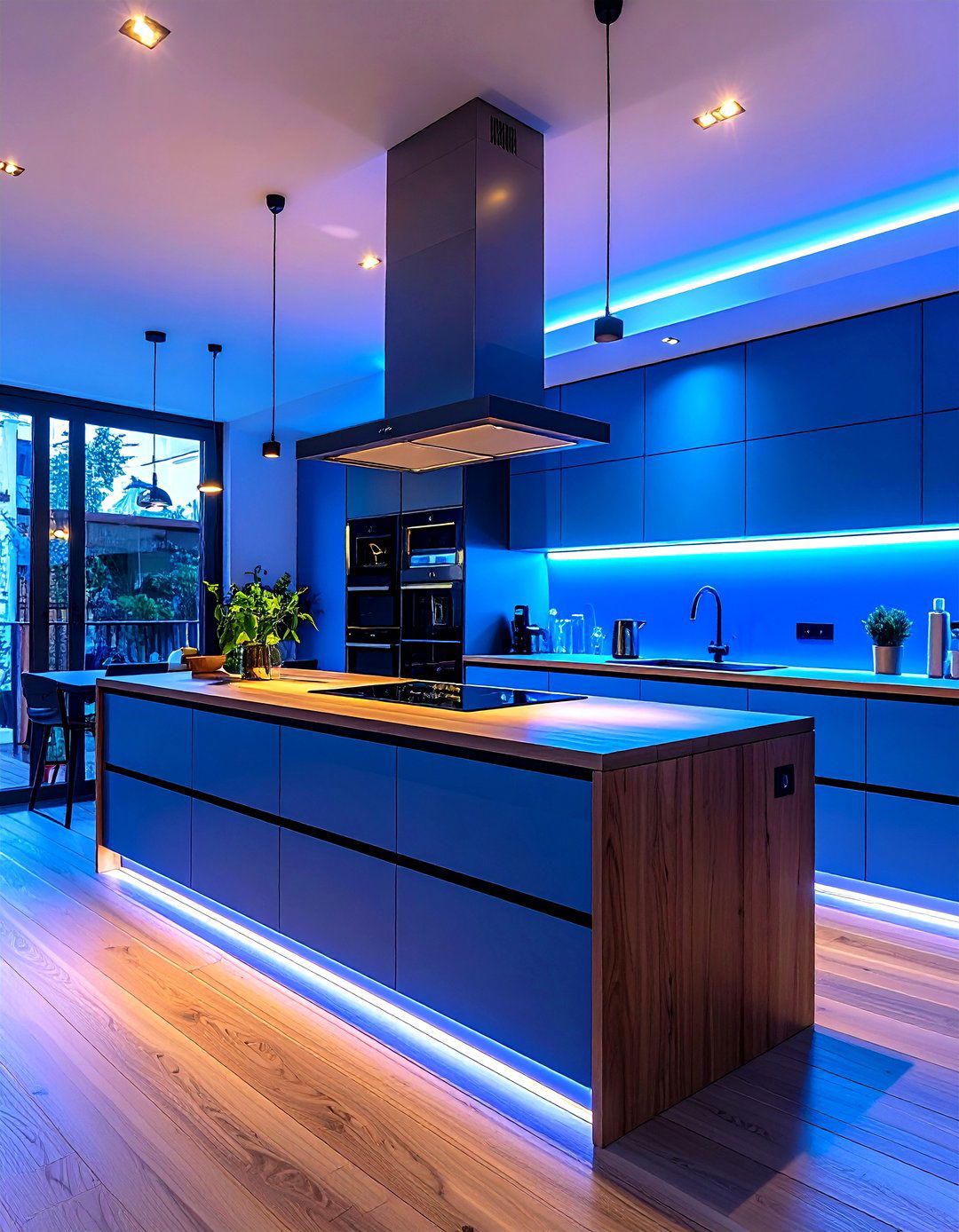
Leave a Reply